4 Practice Templates for Classical Guitar
This article will offer you 4 practice templates for classical guitar.
Contrary to what many people might think it is not in your lessons but rather in your practice sessions where you will improve as a musician. A lesson will shine a light on areas you need to focus on and provide guidance for continual development but it really won’t make you a better player. For this reason we need to think carefully about how we use our time while practicing.
There are two main pitfalls in the practice realm #1 aimless wandering #2 is diminishing returns. Wandering aimlessly in practice sessions is easy to do and it will result in a feeling of frustration and wasted time. To remedy this we need to practice with a structure and goals. Diminishing returns is a little more insidious, and this will happen as we forge ahead thinking that more time = more results. This is most definitely not the case and I would suggest to you that a focused and structured session for one hour is far more productive than three hours of noodling.
This site has a number of practice aids that I have developed: CGC Academy contains a complete suite of tools that provides structure and graded materials for you to work on, and the practice routines are PDF books with structured practice materials. If you want to develop your own practice structures here are four templates to get your ideas flowing.
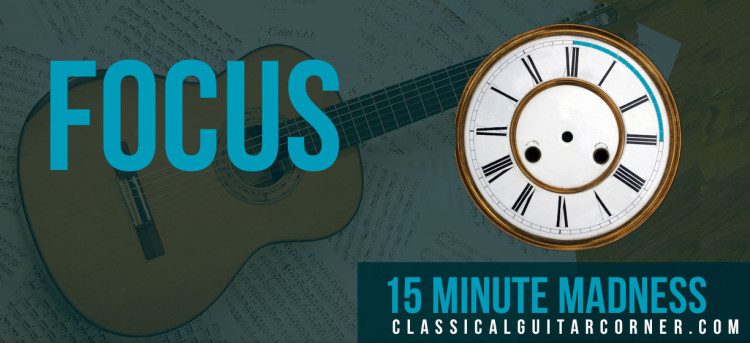
Practice Template 1: 15-Minute Madness
We start with just that little sliver of time that we sometimes find between daily hustle and bustle. Maybe the kids are out, maybe you woke up early, but there is definitely a small window where you can pick up the guitar. If you use this window properly it can be very productive.
The name of the game here is restriction. Take just one thing and focus intently for fifteen minutes. A scale, and arpeggio, four measures of a piece, an exercise. Whatever it is, clearly state your goal and stick to it. Resist the temptation to noodle around on your repertoire. Noodles are your enemy.
Let us say you choose a C Major two octave scale. Start a timer on your phone, put the metronome on and start out with an even scale with consistent tone. From here we can add scale variations such as articulation, rhythms, dynamics or right hand fingering changes. Before you know it, your timer will go off but if you stick to just that one focused element, your time will have been productive.
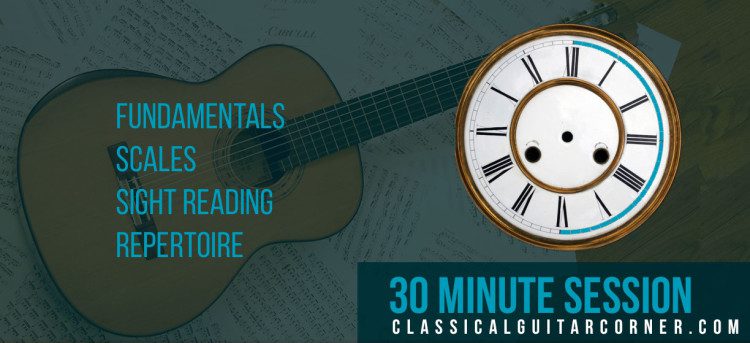
Practice Template 2: The 30-Minute Practice Session
- 10 Fundamentals
- 5 Scales
- 5 Sight Reading
- 10 Repertoire
As a beginner or intermediate player you need to continually consolidate core techniques. Sound production, alternation, string crossing, scale synthesis, all these elements are crucial to your development and they can’t be quickly brushed over. So, to start each of your practice sessions, I would suggest going over your fundamentals.
Fundamentals – 10 minutes
Free stroke, alternation, string crossing, sound production. These simple elements are also great at gently warming up the hands.
Scales – 5 minutes
Focus on one scale and one element of technique. i.e. C Major one octave and focus on correct right hand alternation.
Sight Reading – 5 Minutes
Simple sight reading. I say simple because we want to develop a sense of confidence and flow with reading music. In the Grade 1 Cornerstone Method Course at CGC Academy I add one element per lessons for a while and this allows the student to develop confidence in reading. You could take a basic melody like “Three Blind Mice” and write it down in three different keys, two different octaves, play it in two different positions. Keep your sight reading task simple and add difficulty through variation.
Repertoire – 10 Minutes
Ok, only ten minutes left… now we can focus on the repertoire.
This might seem like a measly portion to assign to repertoire but you can make progress if you focus. If you spend those ten minutes on two measure, or even four, then you can really get some quality work done. If you try and play the whole piece through, you will have wasted your time.
Take a bite sized chunk, and focus intensely. It yields results and will leave you feeling productive. The next session you can move ahead to the next two measures. Over time you can consolidate and form up the entire piece.
Practice Template 3: The 1-Hour Practice Session
With a little more time we can dig deeper into our individual chunks.
- 10 Fundamentals
- 10 Scales & Arpeggios
- 5 Giuliani Right Hand Studies
- 5 Sight Reading
- 15 Studies or exercises
- 15 Repertoire
Fundamentals – 10 Minutes
To reiterate, the fundamentals are perhaps the most important part of your development in the early stages. Start the sessions with open strings, alternation, tone control and extremely simple exercises
Scales & Arpeggios – 10 Minutes
With a little more time we are adding arpeggios to the mix. One or two octave arpeggios will incorporate shifting and string crossing into the mix. Choose one scale and one arpeggio in the same key to focus on for ten minutes. Be mindful of tone control consistency and efficient movement in the hands.
Giuliani Studies – 5 Minutes
The 120 Giuliani Studies provides a great framework to inject two or three studies into a practice session. They each have a slightly unique element and will develop a balanced right hand. Restrict yourself to no more than three in a period of five minutes so you can focus on tone and right hand balance.
Sight Reading – 5 Minutes
As with the 30 minute template, sight reading is an important element to develop and it will also break up the monotony of technical work.
Studies or Exercises – 15 Minutes
To develop individual elements in your technique like slurs, shifting, thirds, sixths etc. you will need to devote time to studies and exercises. This is almost like a more advanced and specific version of the fundamentals your started with.
Repertoire – 15 Minutes
As you can see we have already taken up three quarters of the practice session with technique and musicianship. Technique is more important than repertoire right now because you need to develop a strong foundation. However, with an hour we can look at spending a little more time on repertoire and studies.
With 15 minutes assigned to repertoire you can once again focus on one phrase of music or a four measure chunk. Try not to take on more than that as you will be diluting your efforts. Focus, be patient and persistent and if you feel stuck put the guitar down and think what you could do to improve these short passages. Better sound? phrasing? articulation? dynamics? I guarantee you that there is something you can improve, and you wont get to that deeper, more detailed level if you move on to different material. Stick with it.
Many beginner pieces are not much longer than 16 or 24 measures. With this focused approach you can look forward to gaining control of one piece per week. Not bad!
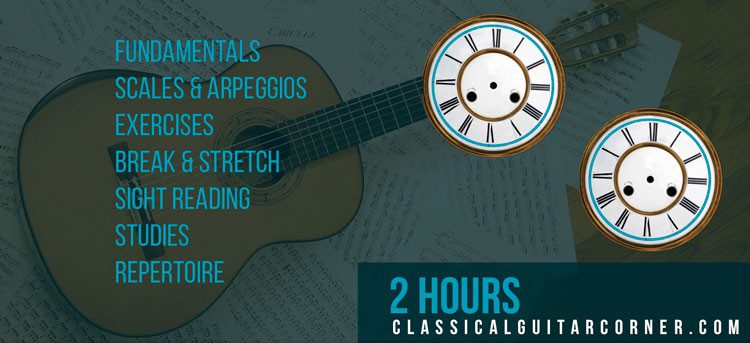
Practice Template 4: The 2-Hour Practice Session
Anything over an hour is a dangerous amount of time to practice. Not because your body is sedentary but because your mind will start to wander. In general I would suggest everyone practice in 45 minute chunks with a 15 minute break if possible
- 15 Fundamentals
- 15 Scales & Arpeggios
- 15 Exercises
- 15 Break & Stretch
- 15 Sight Reading
- 15 Studies
- 15 Repertoire 1
- 15 Repertoire 2
As you can see in this more substantial 2 hour practice session we can expand our time on various components and have also designated thirty minutes to repertoire study towards the end of the session. Each chunk is 15 minutes and in my experience this is an optimum amount of time to make progress without losing focus.
Take the same approach as the previous templates and be clear about the focus of each section. Use a timer to keep you on track and be sure to stretch in that 15 minute break!
Conclusions
These practice routine templates are just outlines which you can adapt to suit your own needs. I feel that they represent the best balance for improvement but perhaps you are more interested in playing through pieces, and that is completely OK.
The most important thing is that you take the time to think about your time so you can feel a sense of progress and achievement.
Need some help to get started?
You can use one of my graded Practice Routines so that you can focus on what really matters… your practice. Each routine provides a structured and balanced technical workout that is comprehensive but not overwhelming. If you don’t want to go to the effort of collecting and arranging all the exercises yourself, then these books will be very valuable to you.
Just choose the books you need and get started:
5 Practice Routines – Book 1

look inside…
$12.95
5 Practice Routines – Book 2

look inside…
$12.95
5 Practice Routines – Book 3

look inside…
$14.95
5 Practice Routines – Book 4

look inside…
$14.95
Practice Routines
We have 20 Practice Routines at Classical Guitar Corner Academy to help you make progress at your level. Each of these routines fits into our graded curriculum and integrates with our graded repertoire. Join CGC Academy today to get access to the Practice Routines and much more!

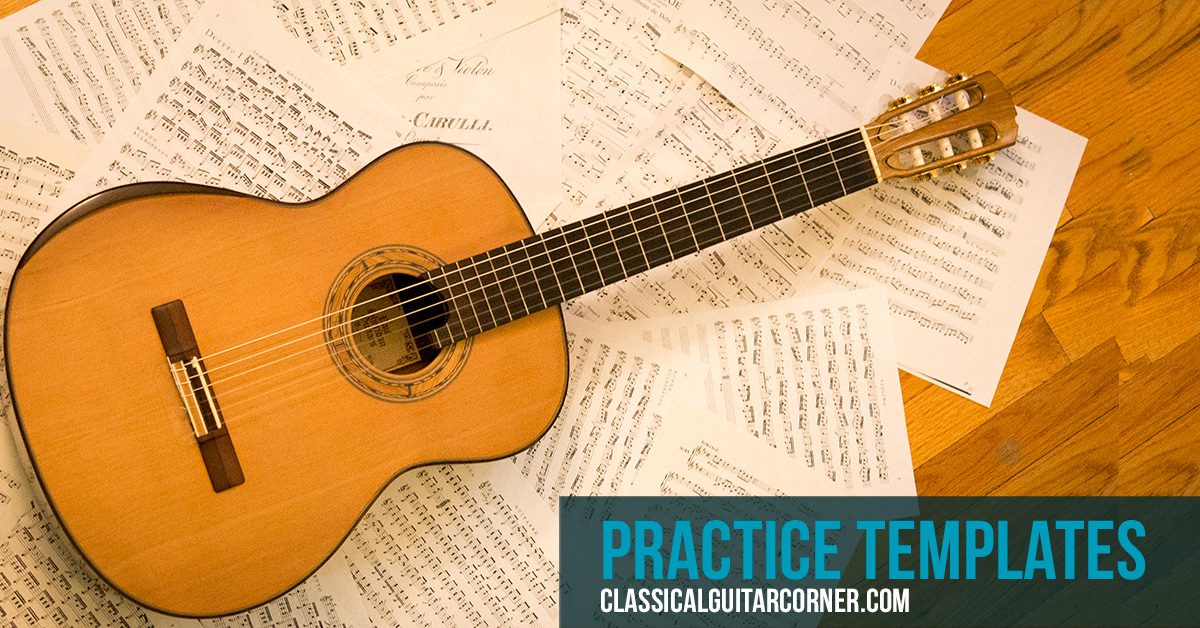
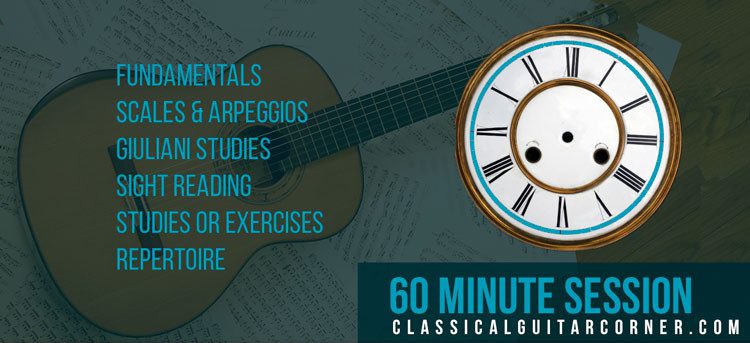
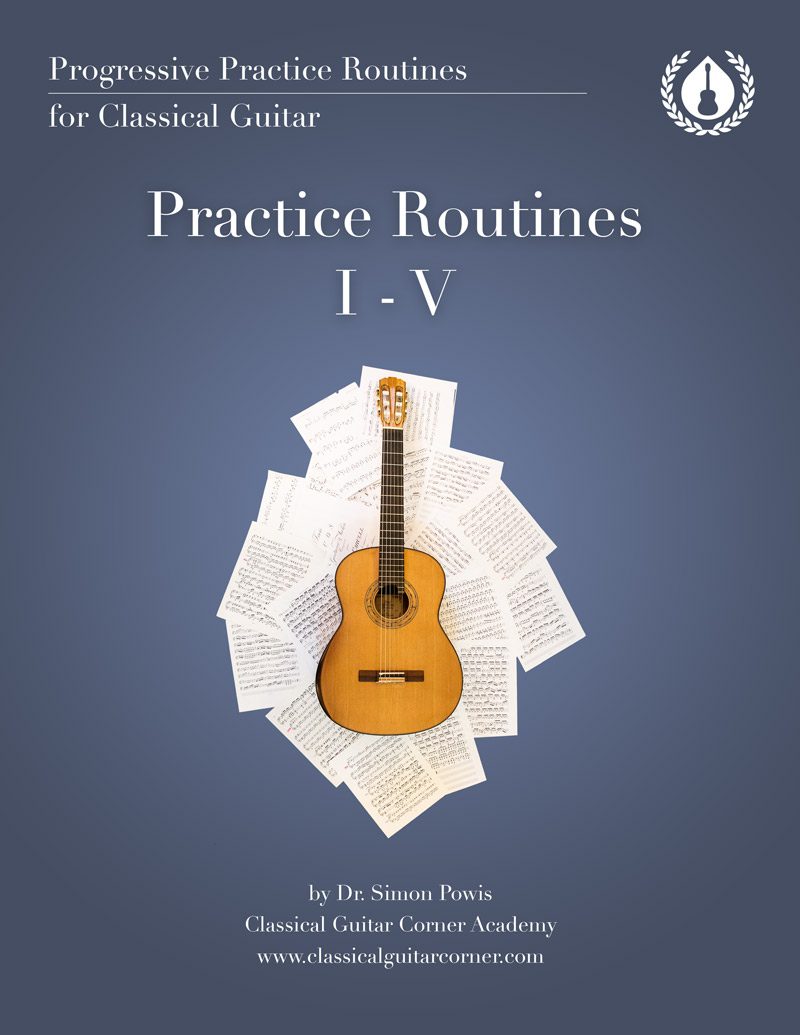
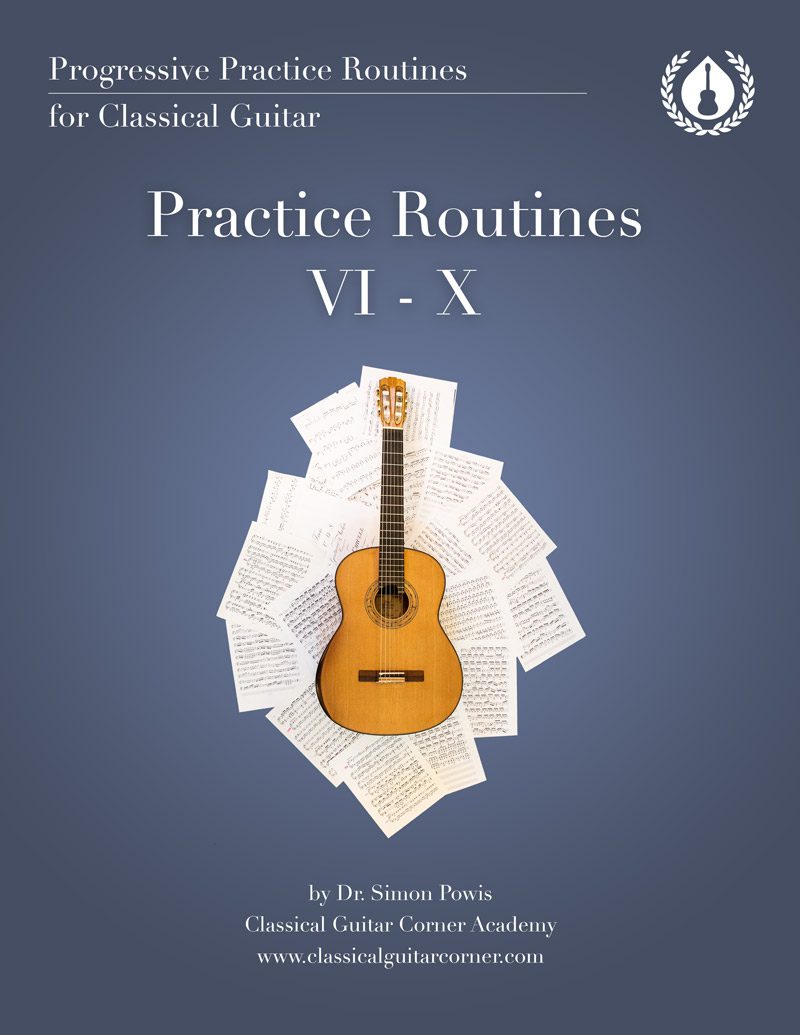
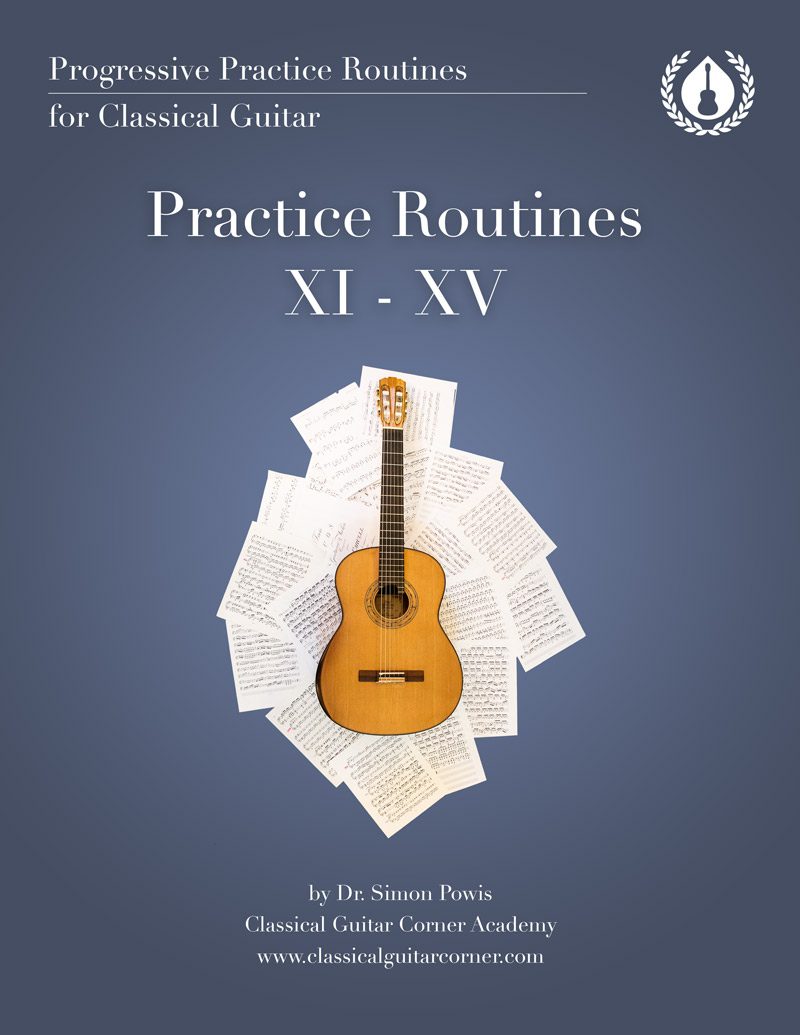
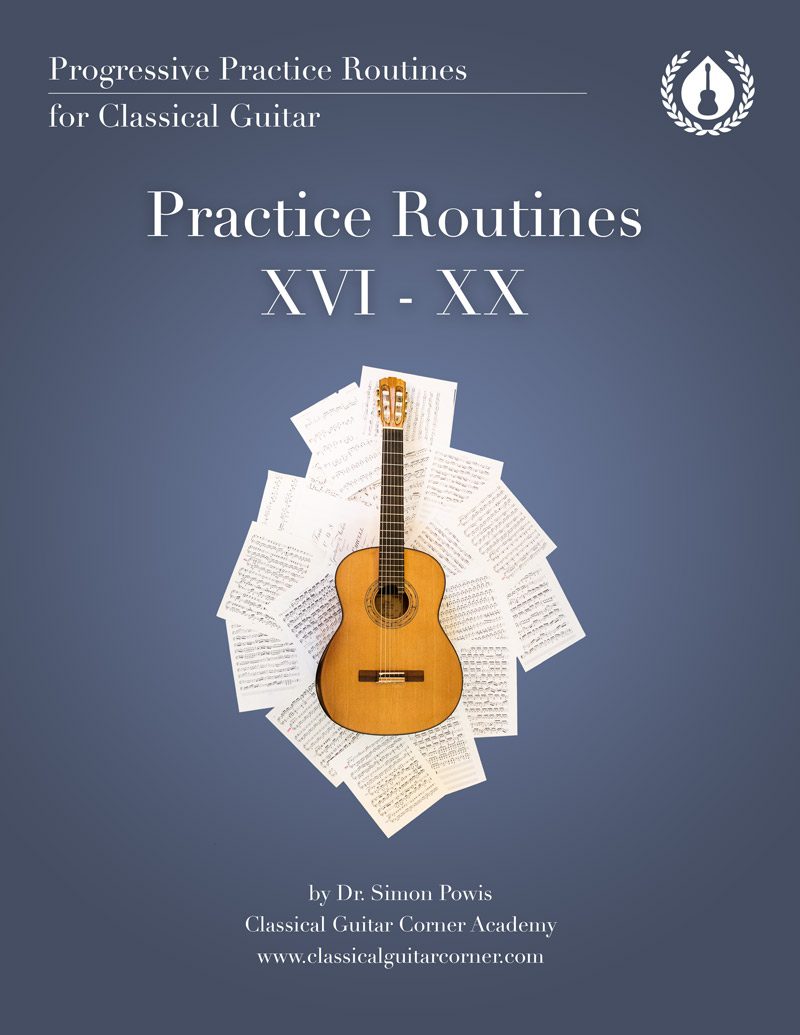
Such great advice and good to be reminded, I’ve taken the opportunity to download a multistep countdown timer ‘WatchMe’ (free desktop application – CNET downloads), it ensures I spend the appropriate amount of time on each element of my practice as well as pushes me onto the next element.
Thanks again Simon
Thanks Simon. Your site and podcast are great: “Be Inspired!” indeed.
To add another twist: how do you suggest organizing a WEEK of practice? Here’s what I do now. During the weekdays, on three days- M-W-F- I have an extended warm up of about 45 minutes of stretching exercises, scales, slurs, and general pumping nylon exercises from Scott Tennant’s book. I follow this with a rest, then work on studies, sight reading and repertoire I am working on. On T-Th, I just work on the pieces and studies and keeping repertoire fresh. On Saturday and Sundays I just try to have fun. I may work on some technique I would like to learn, or a fun piece, like learning Bossa Nova or Flamenco technique or rhythm, or I work on a piece that I would really like to learn cause I just like it. Mood for a Day by Yes, or Eric Satie are my current fun projects. I also save time for reading things, like Seymour Bernstein’s book, your blogs, maybe some theory, etc. I find these help with motivation. Any other suggestions? Like maybe some good sources for music theory for guitar? I really loved Oscar Ghilia’s comments about connecting moments of time over an entire work.
Keep up the good work!
Hi Rick,
Absolutely! 1 week, 1 month, 1 year … 5 years! It starts to morph from detailed mini-goals to very large goals that guide our progress. I truly believe that all of these can be useful and we need to check in and adjust them as we move along.
I am not aware of any really good resources for guitar theory. I am working on building up resources in the practice pass but I am sure there are other resources out there.
Just having the different templates available and choosing which one to follow based on the available time is great, but being able to put that small check mark next each element as I go through which ever template I am using is a sense of accomplishment…baby steps at times, but moving forward…
Thank’s for the illuminating the way….John Rabinowitz
Glad that offers some guidance, John.
Everyone is going to have their own session style that works for them, but hopefully this will get the planning going!
I use an electronic kitchen timer, set for two(2) minutes, to control my technical work such as Giuliani’s RH exercises, Tenant’s Pumping Nylon, or David Mead’s 10 Minute Acoustic Guitar. Workout. I generally spend 20-30 minutes total on this portion of a 1hr practice. I also spend a few minutes doing stretches & finger exercises from a book on piano techniques I picked up 25 years ago.
Thanks very much for this guide. I’ve never been able to settle on a consistent practice program BUT……
Regarding the time spent on sight reading… if I am using Giuliani’s 120 studies, using a scale book, practicing repertoire etc… aren’t I automatically practicing sight reading? I mean, as long as I’m using a score I’m reading it.
An idea I got from Scott Tennant is to xerox the passages that are giving me difficulty and put them in a notebook. Then work through the book in 30 min time slices, learning each page before going to the next. Also serves as a good refresher to just run through. I have often tried to imagine a notebook of only the things that gave him trouble…
This is all about making the best use of time. Great stuff for someone like me who has difficulty finding 90 minutes daily of uninterrupted free time to practice. I was wondering if I could use parts of your 5 Technical Routines for Classical Guitar (Intermediate to Advanced) to cover the section on “Studies or Exercises” 15 minutes, Or is there a specific book of yours I could use..
Such good advice.
Are these materials available/duplicated as part of the regular course membership, or is this material supplementary/extra?
Hi Andrew,
The Levels 1–4 Technical Routines are all included with the annual membership under “Course Materials” in the “Courses” button at the top toolbar of the site. Each level of course has a technical routines book and a repertoire book. But, yes, those are the same books that are included with annual membership.
Peace,
Dave B (CGC team)
Thanks Dave. The different covers were a bit confusing. Got it now.
[…] 4 Templates for Classical Guitar Practice Sessions […]
Very nice practice routines. I just think it would also be good to consider the time required for warm up and stretching before the practice session (something around 10 minutes) and also the breaks we need to take through the practice session, like 2 and half a minute of rest for each 10 ir 15 minutes of actually playing. It might not sound like much time, but after summing them up you may get a considerable ammount of time. So, when choosing to practice for one hour, you may end up consuming 1 hour and 30 minutes from your available time (which actually is what was happening to me).
Simon, just wanted to ask you, as I’m someone very limited time (1 hour in the early morning before work) to play. I once had a great book called Playing the Piano for Pleasure and he recommended focusing on technique from repertoire. Take slurs, for instance, there are plenty of pieces that demand them, so am wondering if you could skip the studies and use repertoire to generate the technical aspects of practice. That way, you get to learn a piece of music and develop your technique. Any thoughts anyone?
That’s a great question, David. Yes, you can indeed take material from repertoire to help develop technique and many guitarists use this approach (check out our podcast interview with Marcin Dylla, who follows this approach). However, what I would recommend (and actually this is also something Simon discussed with Ben Verdery in our podcast interview with Ben) is taking that passage and finding a way to make it “out of context” so that you’re not simply drilling the passage for technical benefits. One issue with making a technical exercise out of a musical passage is that when you go back to the passage it might end up sounding…well, like an exercise! Slightly varying it so you remove it from its original context can really help with this as it will help you develop exactly the technique needed for the passage without actually “drilling” the passage itself. Hope this helps, but let us know your experiences and how it goes!
Peace,
Dave B (CGC team)
I had learned guitar for past 25 years, here is what I learned from my practice.
Any craft practice need strong discipline. Every individual or guitarists have the ability to learn to design or develop their own practice routine and it is depend on the guitarists themselves on where, when, who is our teacher, which repertoire they want to learn or practice and type of skills to master. Only with self discipline and good teacher shall make our learning fun and easy
I love the snazzy new book cover design!
Congrats on all the hard work putting these together!
Kari
I’m wondering about the definition of “noodling,” as I like to go back and play through some of the songs that I have “somewhat” mastered in the past. If I don’t play them now and again I will lose them, so I’m not sure I would call this noodling. Sometimes, just for the fun of it, I go back through my book and play through songs that I particularly enjoy and don’t want to lose. Comments appreciated.
I don’t know what Simon or Dave would say and it depends on how much time you can find but I always try to find 5 or 10 minutes at the end of practise or at another time in the day to play a piece or a study that I know reasonably well and like and just play it for sheer pleasure. After all, isn’t that why we learn to play the guitar?
Cheers,
Lee.
[…] up is very different from a Practice Routine. (Go here for recommendations on how to build a practice routine.) When we warm up we’re just trying to warm up our hands and arms to prevent injury and so […]
I tried to “get the guide” but the page has an error notice and I noticed the URL at the bottom of the page is for https://nycreative/lpages.co/cgc-int/yvqNNoEVUrJNFensDGvjJE
It didn’t seem to have any indication of being related to your Classical Guitar Corner website.
Hi Marquita,
Yes, that link is the correct link to get the guide. The name comes from a collective artist group that Simon started several years ago called New York Creative Group. Best wishes.
Peace,
Dave B (CGC team)
Thank you so much for providing great content to us. I have been always questioning how to structure a good practice for my classical guitar studies and now i found it.
Thank you!!